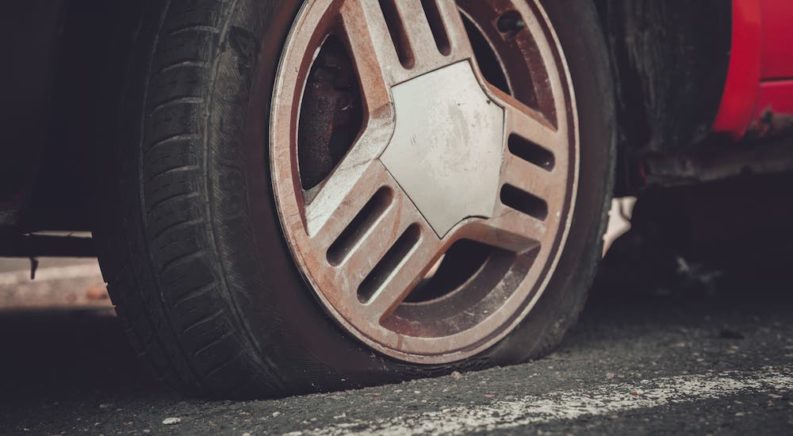Tires are one of the most important parts of your vehicle, but they can be one of the most complicated to deal with at times. There are numerous types of tires, sizes, recommended tire care guidelines, and it can be confusing to keep it all straight. Plus, tires are expensive. Cheap tires that are good quality can be hard to come by, so many people may find themselves asking, “can I just replace one tire?” In short, the answer is yes, but there are only some circumstances where replacing one tire is the best course of action. Most of the time, you are going to want to replace at least two or all of your tires.
How Does Tire Damage Occur?
There are certainly situations where you may be in a position where only one tire needs to be replaced. Oftentimes this occurs during blowouts, flats, or if you roll over something in the road and it punctures the tire. Tires are pretty resilient, but various factors can cause them to weaken or otherwise get damaged.
You can easily puncture one of your tires by running over broken glass, a nail, or another sharp object that punctures the tire. Likewise, the environment can put a strain on your tires, causing them to weaken and potentially tear or blow out. Not to mention, driving over potholes can put a strain on your tires, and accidents can also damage them.
While tires are built to withstand a lot, there are still plenty of factors that can lead to a rip, tear, hole, or leak, causing you to need to replace one, or several, of your tires. However, most people will tell you that if you need to replace one tire, you’re probably going to need to replace them all.

Should I Just Replace One Tire?
Now let’s say you fit into a scenario where one of your tires is damaged, or the treads are peeling, or for whatever reason, just one tire is no longer viable. The next question is: can you just replace one tire? Should you replace just one tire? The answer depends on the situation involving the rest of your tires. Sometimes, you can get away with just replacing the one damaged tire, and sometimes you will end up having to replace them all. A lot of this will depend on the drive type of your vehicle as well as the condition of your other tires.
When you have a two-wheel drive vehicle, if the rest of your tires are fine and meet the sufficient level of tread, then there’s no reason to replace them all, as it’s just an unnecessary expense. However, be wary of doing this because there may be an issue with uneven treading, which can lower the life of all of your tires or potentially cause damage to your wheel. If you do need to only replace one tire, make sure the new tire is paired with the other tire on your vehicle with the deepest tread. This will help mitigate uneven tire wear. Also, put the vehicle on the rear of the vehicle to help prevent hydroplaning.
If you have a four-wheel or all-wheel drive vehicle, replacing one tire becomes a lot more difficult. Systems that use all four wheels will be more sensitive to differences in tire diameters between different wheels, and this can cause issues for the drivetrain system. That’s not to say that you can never replace just one tire in these systems, but check your manufacturer’s guidelines for tire replacement on your vehicle before you do. When in doubt, in this case, it is better to replace all of the tires.
What Sort of Tire Should I Get for Just One Wheel?
This is actually a really important question here because it might seem like a no-brainer to just get another tire that’s equivalent to the one that was damaged, or split, or was flat. However, there are some important steps to keep in mind when it comes to replacing a tire. For one, you will want to get a replacement tire that’s the same as the other tires on the vehicle.
While you may only consider replacing one tire, it’s not always a bad idea to consider replacing all four if you’re heading into a new season and your vehicle is currently equipped with season-specific tires. For instance, if you have a blowout for just one tire at the end of the summer and your vehicle is fitted with summer tires, and you live in a place where the fall is rainy, then it wouldn’t be a bad idea to replace all four tires with all-season tires. Alternatively, if one of the tires is flat or damaged, and it takes place during the winter, and your vehicle is equipped with winter tires, then you will need to get another winter tire to match the other set. Things may get a little tricky if a replacement is required in-between seasons, but again, it’s best at that point to just replace all the tires if you equip seasonal tires.
What you absolutely do not want to do, however, is put a spare tire on and keep the spare tire on. That is not a good idea at all since spare tires are small and aren’t designed to handle the full weight of the vehicle for very long unless the spare is a full-sized wheel with a full-sized tire. Again, you will still want to make sure that even with a full-size spare, the tire treads match the rest of the tires on the vehicle.

What Happens if I Replace Just One Tire?
This has a number of different outcomes. The best outcome is that you replace it and experience no problems. However, it’s not always that cut and dry when replacing a single tire. If you replace just one tire, but you don’t replace the tire with the appropriate tread type, then you can run into some serious problems down the road. This can be an issue if you replace the old tire with just a newer tire of the same type or if you put a different type of tire completely.
For instance, if you have summer tires equipped but then you put on an all-season or winter tire as a replacement for just one wheel, then you’re going to burn through the treads much quicker on the winter tire if it’s being used out of season. The reverse is also true; using a summer tire or touring tire during the winter, you will lose traction and grip on the road, and it will make the handling very difficult for the vehicle on whichever side the out-of-season tire is equipped. This is why it’s important to keep the tires the same, even if you’re just replacing one. Make sure it’s the same make, model, and seasonal type as the rest of the tires on your vehicle.
For all-wheel drive or four-wheel drive vehicles, it’s essential to ensure that the tread depth is also nearly the same as the other tires, or at least within a reasonable depth as the other tires. Otherwise, there could be problems if the older tires have more wear and the newer tire doesn’t. What happens is that the older tires end up doing more work than the newer tire, which could cause more problems for your vehicle in the long run.
When In Doubt, Trust a Professional
If you have the right tire combination with the rest of your wheels, and it’s in the proper season with the right tread depth, then the upside is that you can continue driving your vehicle without any problems, and the tires should last you until the next time you have them scheduled to be replaced. While changing one tire is not recommended in most cases, there are circumstances where you can get away with it. When in doubt, you should always check with a tire professional for their advice on if you can get away with changing one tire or if you need to replace multiple. In the case of your tires, it’s better to be safe than sorry.

